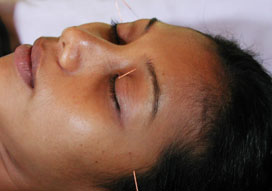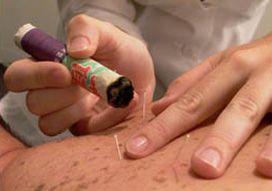
 The art and science of acupuncture has been used and refined in
The art and science of acupuncture has been used and refined in
There are hundreds of loci on the body precisely mapped along channels or meridians, which allow access to this energy flow. These areas are called acupuncture points and can be stimulated with acupuncture needles, moxabustion or electricity. The acupuncture needles I use in my practice are very fine, sterile, disposable and made of stainless steel. They are placed strategically along the channels or energy pathways of the body in order to move the blockages and rebalance our system.

 Sho-ni-shin is a Japanese system of acupuncture used for infants and children which originated several hundred years ago in the Kansai area (
Sho-ni-shin is a Japanese system of acupuncture used for infants and children which originated several hundred years ago in the Kansai area (
It makes use of small metal tools designed specifically for children, which stimulate the channels and acupuncture points without penetrating and breaking the skin. Hence, it is non-invasive and painless. It is very comfortable and does not cause any discomfort to the child, who learns to enjoy the sho-ni-shin treatment and looks forward to be treated again.
In spite of this relative ease, this type of treatment can be quite effective for most chronic and constitutional disorders and can also be used to boost a weak immune system, as a preventive or maintenance for good health.

 Moxabustion is called moxa for short. It is made of mugwort, a plant with has deep healing faculties and the ability to burn slowly and evenly. It is dried and rolled and used to warm up the various acupuncture points. It can be placed directly on the skin or held by the hand a short distance from the skin. Moxa is usually used with or instead of needles in order to warm or tonify deficient conditions.
Moxabustion is called moxa for short. It is made of mugwort, a plant with has deep healing faculties and the ability to burn slowly and evenly. It is dried and rolled and used to warm up the various acupuncture points. It can be placed directly on the skin or held by the hand a short distance from the skin. Moxa is usually used with or instead of needles in order to warm or tonify deficient conditions.

 The practice of Chinese Herbal Medicine can be dated back from at least 200 B.C. As in every ancient culture, it used to be associated with shamanism, blending herbs and magic together. For the last 2000 years, the thousands of substances, which include a great majority of plants and also some animal and mineral products, have been systematically recorded, listed and organized in Materia Medicas or herbal pharmacopeias , which have been continuously updated and revised ever since.
The practice of Chinese Herbal Medicine can be dated back from at least 200 B.C. As in every ancient culture, it used to be associated with shamanism, blending herbs and magic together. For the last 2000 years, the thousands of substances, which include a great majority of plants and also some animal and mineral products, have been systematically recorded, listed and organized in Materia Medicas or herbal pharmacopeias , which have been continuously updated and revised ever since.
Nowadays, this ancient and time-proven knowledge has been enhanced by modern research. Each herbal and non-herbal substance has been scientifically tested to determine its therapeutic functions, its medical use, its chemical components, its toxicity and its pharmaceutical actions.
When used properly, herbs can be a fast and efficient relief in most acute disorders. They can also be used safely in protracted and long term chronic problems because they are gentle on the body and free of side effects.
Acupuncture and herbs can be practiced separately as two different sciences. However, they have traditionally been used together as each can greatly enhance the therapeutic effect of the other.

 Classical homeopathy is a natural medical science which was brought to light by Samuel Hahnemann, a German physician in the 19th century. It makes use of potentized (extremely small, diluted and energized) doses of substances from the plant, mineral, metal or animal kingdom in order to bring a person back to health. Homeopathic remedies can be used in emergency and acute situations as well as for chronic and constitutional imbalances. Homeopathy is a powerful and unique system of healing because it is prescribed not just according to the symptoms, but according to the full picture of the disease and to the ways each individual experiences and manifests the disease.
Classical homeopathy is a natural medical science which was brought to light by Samuel Hahnemann, a German physician in the 19th century. It makes use of potentized (extremely small, diluted and energized) doses of substances from the plant, mineral, metal or animal kingdom in order to bring a person back to health. Homeopathic remedies can be used in emergency and acute situations as well as for chronic and constitutional imbalances. Homeopathy is a powerful and unique system of healing because it is prescribed not just according to the symptoms, but according to the full picture of the disease and to the ways each individual experiences and manifests the disease.



